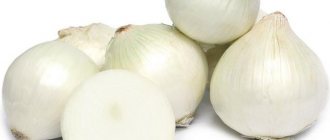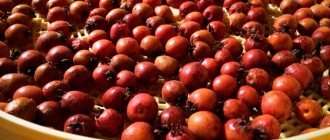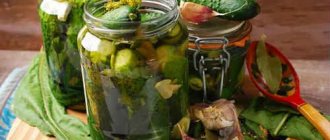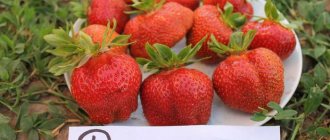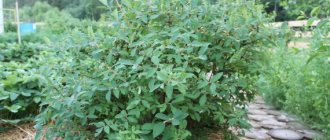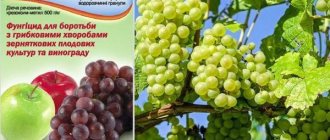Anzur onion is a plant of early ripening, characterized by an attractive appearance and healing properties, appreciated by ancient physicians.
In its wild form, such a wonderful culture is found in the mountainous territories of Central Asia, where it is actively consumed as food. Perhaps this is why people living in this area are distinguished by good health and enviable longevity.
Varieties of mountain onions
Anzur onion, the beneficial properties of which have been appreciated by more than one generation, combines 3 types:
- Stalked. It is characterized by round, somewhat flat bulbs, covered with thin scales of a grayish or white color and ranging from 4 to 8 cm in diameter. The wide leaves are well pubescent, flat, collected in a rosette; They are about half a meter in height. The stem is thin and quite flexible. The inflorescences are spherical umbrellas of lilac color with a diameter of about 10-15 cm.
- Giant. It has a round or ovoid bulb, flat wide leaves and a powerful, about 150-160 cm high, dark green stem. The inflorescence is quite large, spherical in shape, with beautiful purple flowers.
- Suvorov. The bulb is round, 6-8 cm in diameter. Often, daughter bulbs are formed on the sides, covered with white-silver scales. The leaves are bluish, pubescent along the edges. The height of the stem is 80-140 cm. The diameter of the inflorescences (spherical and hemispherical) is from 10 to 12 cm. The flowers are pink-violet in color, dark veins are clearly visible on the petals.
Description of onion-garlic Anzur
The plant appears first in the beds in early spring . Grows in the form of a bush. At first it resembles a tulip, but over time it becomes like garlic. The stem is powerful, with slightly protruding veins, from 0.3 to 1 m in height. The onion has 3-7 green leaves, belt-shaped and 0.5 to 2 cm wide. They are rough to the touch along the edges and reach 50 cm in length.
The plant produces one arrow up to 1.3 m high . At its top an inflorescence is formed in the form of a ball with small pink-violet flowers. Petals are linear, with a blunt tip. The diameter of the inflorescence is up to 15 mm. The fruit is an egg-shaped capsule, the seeds are black, triangular. The bulb is spherical, the shells are leathery, grayish.
Origin and development
Anzur grows in the foothills and mountainous regions of Middle and Central Asia, the Tien Shan, and Altai. Anzur onion is listed in the Red Book.
Interesting! According to its medicinal properties, anzur is compared with ginseng.
Mountain onions have two main varieties:
- with pronounced ribbing on the stem: Giant onion Anzur, Dutch, Yezdian, McLean onion, Pinkest onion, Suvorov onion;
- with a smooth stem surface: Aflatunsky, Vysochaishy, Rosenbakh, Zarevshansky, Stebelchaty.
Chemical composition, trace elements, vitamins, beneficial properties
The bulbs of this plant contain vitamin C (4 times more than onions), D, E, carotenoids, phytoncides, steroids, alkaloids, and mineral salts. Due to the presence of saponins and a specific unpleasant odor, the vegetable is heat treated.
Beneficial features:
- enhances metabolism, promotes weight loss;
- increases human immunity;
- prevents the aging of the body;
- has an analgesic effect;
- helps reduce blood sugar;
- used in the treatment of respiratory diseases;
- improves brain activity and improves memory.
Onions are used for glaucoma, skin diseases, impotence and urolithiasis .
Important! Use with caution for people with cardiovascular diseases and those prone to allergies, as this vegetable can cause an unpredictable immune response in the body.
Ripening time and yield
Ripening lasts from late July to early August . Drying, yellowed leaves and stems are reliable signs that the onion is ready for harvest.
On average, up to 6 kg of crop is harvested from 1 m² .
Characteristics of the bulb, description of appearance, taste
The bulbs are large, spherical in shape, up to 8-9 cm in diameter . The shells are leathery, grayish, splitting. Consist of two or three cloves. The taste is reminiscent of fresh radish.
Growing regions and climate requirements
Suitable for growing in regions with warm or hot climates. The bred species and hybrids of this onion are able to grow in colder areas. The vegetable does not tolerate waterlogged soil, so it is not advisable to grow it in regions with frequent rains during the growing season.
Bow Anzur
Onion-anzur: use in folk medicine
The healing properties of the anzur onion were tested by Suvorov’s army. Warriors were able to recover from scurvy and maintain their fighting efficiency precisely thanks to this plant with a tall flowering stem and spherical purple inflorescences. The bulbs contain biologically active substances such as phytoncides, mineral salts, carotenoids, saponins, ascorbic acid, vitamin E, D, C (the content of the latter is several times higher than in onions). It is believed that such a plant can slow down the aging process and helps older people get rid of the “bouquet of diseases” that has befallen them. Anzur onion is a medicinal plant that helps improve hearing and vision, and can relieve dizziness. When baked, in combination with honey and milk, it solves the problems of colds and stomach diseases. The squeezed juice is used in the treatment of rheumatism; effective for hair loss (requires rubbing into the scalp). The healing plant has a positive effect not only locally, but also on the entire body as a whole, increasing its immunity and cleansing it of harmful substances.
Application in landscape design
Onions have beautiful spherical inflorescences. It is widely used in landscape design. It is considered a wonderful decoration and a symbol of benefit. One of the onion’s nicknames is Aflatunsky. It is he who is the favorite specimen of gardeners.
Diseases
Onions are exceptionally durable. More details:
- Frost resistance;
- Strong immunity.
Flaw:
- Doesn't cope with drought. (dies)
The plant loves moisture, but if you overdo it, otherwise rot will form, and gradually it will begin to eat away at the onion.
Pests
A very important property is that there are no pests on this onion. What this is connected with is not known, but it is a fact.
Collection
Harvest in early June, during the hottest time of the year. The seeds are black. The assembly begins when the onion seeds catch your eye.
Characteristics of mountain culture
Anzur onion is a native of mountainous regions, characterized by a short life period, which fits into the spring season, and a long dormant period. Young feathers of the plant appear in early spring, almost from under the snow. This is the very first vitamin green, and therefore it is important not to miss the moment of its consumption. After all, the leaves are edible only during the first weeks, then they become yellow and coarse. The taste is similar to garlic; used in the preparation of salads, appetizers, first and second courses. In early spring, in the absence of a full complex of vitamins, a sandwich consisting of a piece of bread and a green onion placed on it will be very useful and beautiful.
Care
The main point in effectively growing onions is proper and timely feeding. The first fertilizers are applied immediately after the snow melts. These should be nitrogen-containing fertilizers; the best option is urea (10 grams of urea per bucket of water). You can also use ammonium nitrate, ammonium sulfate, ammonium chloride, mullein. After 10 days you can repeat.
Before direct planting, seven grams of nitrate per square meter are added to the plowed soil.
Don’t forget to loosen the soil after this.
The main disadvantage of Anzur is that the slightest deficiency of potassium in the soil causes deformation and yellowing of the leaves. Therefore, you should always be on alert and apply potash fertilizers on time. Do not forget that mountain onions, like any other plant, have diseases and pests. The most important diseases to which onions are exposed are gray rot and powdery mildew. Read about powdery mildew on cucumbers. If not recognized in time, it can lead to the death of the entire plant. First, a fluffy coating appears, which turns into mold. At this stage, the disease is practically untreatable. Other diseases are:
- powdery mildew;
- mosaic;
- fusarium;
- smut;
- jaundice;
- rust;
- helminthosporiosis;
- tracheomycosis.
You should not lose attention to the fact that for some insects the onion is food. The pests of stalked onions are the same as those of garlic. These are onion fly, mole cricket, onion fly, onion moth, centipede, etc. You can use drugs that are offered in large quantities in stores. But don’t forget that everything you “put” into your plant will come back to you. Therefore, it is worth remembering the folk methods of getting rid of pests, which are no less effective.
Gardeners growing the plant in central Russia have noticed that ants simply adore giant onions. Whole colonies are moving towards onion plantings. Experienced gardeners advise diluting Valocordin in strong tea and spraying the areas around the plant and the onion itself with this liquid.
If you want to grow from seed and get strong, mature bulbs, remember that the arrow should be carefully removed without pulling it out, so as not to harm the entire plant.
Anzur on the dining table
Pickled onion (garlic) anzur is often served with shish kebab and pilaf in Shakhrisabz, Samarkand and other cities of the Samarkand region. We can say that in the rating of snacks for alcohol, this culture comes before pickled cucumbers.
The taste of pickled anzur onions, the recipes for which are well known to residents of mountainous regions, resembles sour-salted cabbage stalks of yellow and milky white color. And this divine aroma: garlicky, delicate, unforgettable.
Beneficial features
Aflatun onions surpassed onions in biochemical composition, and ginseng in beneficial properties. In terms of nutritional value, it is compared to radishes. It contains a high content of ascorbic acid.
The culture includes:
- vitamins: A, PP, B, E, D;
- phytoncides;
- mineral salts - magnesium, phosphorus, potassium, calcium, iron, nitrogen;
- fructose, glucose, sucrose, maltose;
- carotene;
- saponins;
- citric and malic acid;
- glucosides and essential oils.
The small amount of proteins and fats in the composition is fully compensated by other important components. Grated onions release phytoncides that can kill pathogenic bacteria. One piece of onion can destroy all microbes in the oral cavity.
Typically, such onions are not consumed raw, due to the unpleasant odor that disappears after pickling. Medicinal supplies help cope with many ailments, such as:
- brain spasms;
- pathologies of vision and hearing;
- reduced potency in men;
- senile tremor;
- frequent dizziness;
- colds.
Elderly people are advised to take Anzur on a regular basis as an effective remedy for improving memory, hearing and vision. Vitamins E and D prevent the development of rickets and oncology, enhance the body's protective functions, rejuvenate and prevent the appearance of early signs of aging.
The essential aroma emanating from the culture due to phytoncides is widely used in the treatment of the common cold. To do this, tampons soaked in onion juice are placed in the nasal sinuses several times a day for 10 minutes. Inhalations help with sore throat and purulent accumulations in the lungs: the bulbs are ground into a paste and breathed on. Systematic consumption of juice lowers the level of “bad” cholesterol in the blood and relieves rheumatic attacks. This liquid is also rubbed into the hair roots to strengthen them.
The bottom of the head and the adjacent part are of the greatest value, which should be kept in mind when cleaning the bulbs.
Baked allium has a beneficial effect on the digestive system and regulates blood sugar, which is important for people with diabetes. Fresh juice mixed with honey and milk copes with:
- depression and increased irritability;
- headaches;
- inflammatory processes of the gastrointestinal tract.
Anzur has a positive effect on the cardiovascular system and improves blood circulation.
The leaves are a valuable source of vitamins, so they are cut for salads in early spring. It is important not to miss this moment, since they are suitable for food use for no more than 2 weeks, until flowering begins. This is an effective remedy for vitamin deficiency and exhaustion. The ground onion is used to treat various skin pathologies: eczema, psoriasis, lichen, wounds, boils.
The main advantage of the culture is its ability to protect a person from scurvy. It is recommended to include pickled onions in your regular diet, especially in winter, when the body lacks vitamins and nutritional supplements. For elderly people and workers engaged in mental work, the vegetable will help maintain vitality and recover faster from overexertion.
With regular use of properly prepared pickled onions, you can significantly improve the functioning of the digestive system and get rid of joint deformities.
Allium, along with its decorative qualities, has found its application in the culinary and medical fields. Usually, medicinal formulations are made from it or preserved for future use.
You need to consume onions in moderation - no more than 3 g of raw product, otherwise an allergic reaction may develop.
Recipe 1
Marinated Aflatun onions go well with shish kebab and pilaf, served as an appetizer with alcohol along with pickles. This product is quite popular in oriental cuisine. The taste is reminiscent of salted cabbage stalks with a slight sourness and garlic aroma.
Pickled heads are suitable as a healthy ingredient for salads and meat dishes.
For the recipe you will need:
- Aflatun onion;
- 1 glass of water;
- 60 g vinegar;
- 3 tbsp. l. granulated sugar;
- 0.5 tbsp. l. salt.
Sequencing:
- The heads are cleaned, cut into plates and placed in a glass jar.
- Mix the bulk ingredients, add water and bring to a boil. Then vinegar is added.
- The resulting brine is filled into jars with onion preparations.
After 3-4 hours the appetizer will be ready. This marinade is universal and suitable for other vegetable crops: cabbage, peppers, cucumbers. Before putting pickled allium in the salad, squeeze it out.
Recipe 2
Another recipe for pickling decorative anzur onions, longer cooking.
Ingredients:
- small onion heads – 250–300 g;
- vinegar 3% – 250 ml;
- table salt – 400 gr.
For a glass of water you will need 27 g of salt and 15 g of vinegar essence.
Cooking method:
- First of all, carefully remove the peel and place the bulbs in a glass or ceramic container.
- Fill with saline solution.
- Leave for three days, then drain and replace the brine with fresh one.
The process takes about 1.5 months. The onions are then dipped in grape vinegar. You can replace it with a mixture of dry wine (500 ml) and vinegar (15–18 ml). The first sample is taken after 3–4 days. During this period, the onion has time to change: first it darkens, then turns white, acquires the required hardness and is saturated with marinade.
By adding anzur to various dishes when cooking, you can not only transform the taste of food, but also bring significant health benefits.
Growing the crop is simple and does not require much effort and time. At the same time, such plantings will become a worthy decoration of the garden. When cut, the plant is no less decorative and lasts up to 2 weeks. It is recommended to plant onions in groups against a background of trees and shrubs.
Source
Other useful and medicinal plants
Application of ginkgo biloba, benefits and contraindications of the plant
Yasnotka - medicinal properties, contraindications, application
Medicinal properties and contraindications of Lakonos, how to use
Medicinal properties and contraindications of chasteberry, how to take it
Anzur in the household
This culture, characterized by small round bulbs and bluish leaves with pubescent edges, can be easily, without much effort, grown on your own plot as an ornamental and medicinal crop, the chic purple balls of which will become a worthy decoration for any, even the most modest, flower garden.
When cut, they can last for about 2 weeks. The flowering arrows of anzura, which are about 1.5 meters in height, are excellent honey plants; sometimes you can count up to 20 bees on one purple ball.
The plant is highly resistant to pests and diseases and is very winter-hardy; planted for the winter, it retains its vitality even after the soil freezes and germinates well with the arrival of spring. Do not plant bulbs in places with stagnant water; Anzur onion is sensitive to high soil moisture and may die.
Suvorov's bow - care
The plant does not require any special treatment. Mountain onions require the following care rules:
- Watering norms
. In spring, the soil is still moist from melting snow. Then it is important to monitor the condition and water without allowing the liquid to stagnate. - Loosening the soil and weeding
. The plant loves light and loose soil. Immediately after the snow melts, loosening is carried out, raking the earth towards the stem. Weeds are removed immediately after they appear to prevent soil weakening. - Feeding
. After the first leaves appear, urea, ash or nitrogen fertilizers are added. During the growing season, the decorative onion anzur needs potassium fertilizing; it is applied twice per season. - Preservation from diseases and pests
. The main method of prevention is a high location of the bed. For lesions, you can use fungicides, for example, Bordeaux mixture.
When to dig up Suvorov's onion?
The harvest period occurs when the foliage is completely dry. Afterwards, the bulbs are cleaned of soil and dried. Knowing the time when to harvest Suvorov's onions, it is important to choose a period without precipitation so that the heads have time to dry well in the fresh air. Then calibration is carried out: large onions are used for food, and smaller ones are left for storage in a dry and cool room.
Seed propagation method
Anzur onion is propagated by seeds and cloves. The seed method is quite long; the period of development of the bulb to the consumer stage is from 4 to 5 years. Sowing seeds, which are much larger in size than onion seeds, is carried out in October–November at a shallow depth: 1.5-2 cm.
The appearance of green shoots can be observed in early spring: late March - early April. In the first year of growth, anzur forms cotyledon leaves and bulbs, but they are very small, up to 2 cm in diameter. During the dormant period (end of May), they need to be dug up, dried and stored until autumn planting. You don’t have to dig up the bulbs and leave them until the next season, but then, for better development of the plant, you should definitely plant them less often. With the arrival of autumn, anzur needs to be planted in the ground, maintaining a distance between plants of at least 5 cm, between rows of 25-30 cm. Planting depth is 5-7 cm. The next year, real leaves grow and the bulbs increase almost 3 times. Growing from seeds is a very long process: a large marketable bulb can only be obtained in the 4th year.
Description of the plant
Anzur onion, Suvorov onion, giant, Dutch, stalked, tall - all of these names belong to one perennial plant - wild onion, which has a huge number of varieties. The natural habitat of the culture is the territories of Altai and the western region of Central Asia - gorges, mountain slopes, salt marshes.
However, it is cultivated in almost all corners of the world. And this is not surprising, because the spicy culture is “not capricious” either to the soil composition or to the climatic conditions. Since there are many species and subspecies, as well as hybrids obtained through breeding work, their external parameters also vary.
But this bow has common characteristics:
- At the beginning of the growing season, the green part is similar in appearance to tulips, and as it grows it becomes more and more similar to garlic, only much larger in size.
- The stems are tall, from 1 to 1.5 m, in some subspecies they can grow up to 2 m in height.
- The leaf blade is wide (up to 10 cm), shaped like lily of the valley leaves, only larger in size. The leaves are the earliest “vegetable” greens, but after a short time (14–20 days) they become coarser, become hard and fibrous, turn yellow and become unsuitable for food.
- A distinctive feature of ansurs are decorative spherical inflorescences of small bright lilac or white flowers that appear in the upper part of the onion.
- The underground part of the plants is formed in the form of huge bulbs (can reach 15 cm in diameter), which appear 2–3 years after planting the plant on the ridge.
- The taste combines both onion and garlic flavors, but at a more mature age, the taste of garlic increasingly prevails. In this regard, the culture is used as a savory preservation.
Important! Anzur bulbs cannot be consumed raw, as they are poisonous! The vegetable should be pre-treated (soaked, pickled).
Reproduction by teeth
Anzur onions can be propagated by cloves - a method that is more common and takes less time. They are dug up when the leaves of the plant have completely dried out. The planting depth depends on the size of the cloves: for large specimens it is 15-20 cm, for medium-sized ones - 10-12 cm, for small ones 5-7 cm. Unlike garlic, which immediately forms lobes, the anzura bulb increases in size gradually, every year .
It should be taken into account that when planted early, the bulbs tend to divide into 4-6 segments; at a later date (October-November), the division is minimal and the yield of whole bulbs is much greater. In May, bolting occurs, the formation of lilac balls of flowers; Seed ripening occurs in June-July. To grow a large onion, the arrows must be broken off. After the end of the growing season, the anzur onion goes into a dormant period.
How to propagate anzur onion?
In addition to the seed method, vegetative propagation is practiced (by children, slices, bulbs). This method is considered simpler. To do this, the planting material indicated above is placed in the prepared soil, deepened by 13–15 cm and maintaining a distance of a quarter meter.
Bulbs for propagation. It is important to plant before frost sets in so that the material has time to take root well.
Features of care
The anzur onion, which can be grown even by a novice in agriculture, is not a capricious plant at all. For normal development, a temperature of +15-25 oC is enough for it. Moderate watering is recommended; The plant has a negative attitude towards any stagnation of water.
It is recommended to periodically fertilize such a garden crop: with nitrogen-containing fertilizers after emergence (1-2 times), twice with ash and potassium sulfate during the growing season.
Onion care
Stem onions should be watered in doses, avoiding waterlogging of the soil layer even for a short time. After each irrigation, loosening is carried out and weeds are eliminated along the way.
Fertilize the vegetable plant, adhering to the following schedule:
- nitrogen fertilizing (urea) - upon emergence of seedlings;
- spraying with “Ferovit” - 14 days after the first fertilization. It will enhance the process of photosynthesis in the leaves;
- wood ash + potassium sulfate - add the mixture three times during the entire growing season of the plants. Combined with loosening the soil.
Did you know? The world leader in onion consumption per capita is Libya. In a year, according to statistics, every citizen of the country eats 33 kg of vegetables, while in France this figure is only 5.6 kg.
About anzur onion and its varieties
It is characterized by its short growing season, which occurs during the period when the snow begins to melt and ends even before the heat sets in; the onions are mostly large and flat-rounded.
In the spring, we can see pinkish, elastic sprouts under the snow, and when they grow, they become green, large, wide, linear, pointed, elliptical or long.
It is for such a bow that the average height is one hundred centimeters, and its maximum height is about one hundred and fifty centimeters.
The species that belong to the ansur group and are the most popular are:
- stalked onion,
- giant,
- Aflatunsky,
- tall and highest.
Onion propagation
Such onions are propagated vegetatively by dividing a nest of bulbs, naturally, after the leaves have withered. There are many species that also reproduce by seeds. For example, aphloon onion has the excellent ability to germinate only in warm weather, while giant onion is characterized and desirable by cold weather.
If the conditions for such types of onions are only favorable, then self-seeding very often occurs. But flowering occurs much later, about two or four years after it was sown. If you want to transplant your seedlings, be sure to remember that they can tolerate transplantation well only at the initial stage of growth, but it is better not to touch them at all, otherwise they will disappear completely.
By the way, few people know that you can effectively grow green onions at home, even in winter.
The story about the anzur onion would not be complete without talking about its decorative role in design and landscape. Anzur flowers will always delight you with their beauty, but we can also see them not only blooming in our own areas, or in bouquets made with our own hands, but also in dry form, compositions, and they look especially beautiful in floor vases.
It is useful to learn about the correct placement of a regular bow.
If you find an error, please select a piece of text and press Ctrl+Enter.
